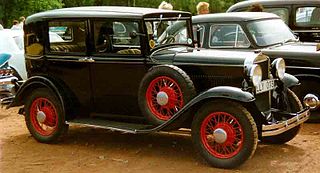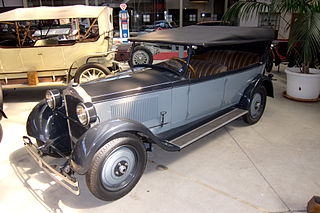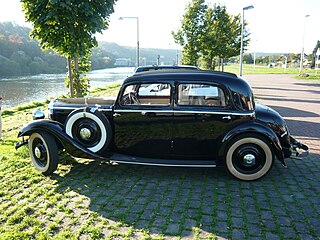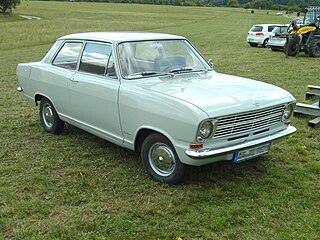Origins
The 1.3-litre can be seen both as a potential successor and as complementary to the popular Opel 1.2 litre, though production of both cars was formally ended in the Autumn of 1935. The 1.3-litre, developed by General Motors in North America, was like its predecessor engineered with ease of manufacture in mind. The car was designed around a new “torsion resistant” box frame chassis and featured a fashionably streamlined body that incorporated, at the back, an unusually large (by the standards of the time) trunk/boot which could be accessed via a lid from outside the car. [2]
The brakes were now hydraulically controlled, [3] in place of the cable based system that had stopped the 1.2-litre, and which continued after 1935 to be fitted on the upgraded version of the smaller model, the Opel P4.
Modern bodies
The fashionably stream-lined body was available as a two-door “Limousine” (sedan/saloon) priced in 1934 at 2,650 Marks. Also offered was a four-door “six-light” limousine. A “Cabrio-Limousine” with a foldaway roof-hood was available with either two or four doors. Buyers preferring to make their own arrangements could select an Opel 1.3-litre in “base-chassis” form for 2,150 Marks. The listed prices increased by 200 Marks in 1935, which was consistent with the continuing period of inflation experienced by the German economy in 1934.
The Opel 1.3 litre was introduced at the same time as the Opel “6” 2-litre, and was superficially similar to the four seater bodied Opel 2-litre, both cars featuring the then newly fashionable streamlined style. The 1.3 litre was nevertheless significantly shorter than even the short wheel base version of the 2-litre, with a 2,474 mm (97.4 in) wheelbase compared to the 6 cylinder car’s 2,642 mm (104.0 in) wheelbase. At the same time, the 1.3-litre had a wheel-base that was nearly 200 mm (7.9 in) longer than the 2,286 mm (90.0 in) wheelbase of the smaller Opel 1.2 litre. With its elaborate suspension and new robust chassis the 1.3-litre was also, at 700 kg, more than 20% heavier than the 1.2-litre in base chassis form, and nearly 30% heavier once Opel’s standard two door saloon/sedan body had been attached. Despite this, the 24 PS (18 kW; 24 hp) maximum output from the car’s engine was just a single 1 PS (1 kW; 1 hp) higher than on the smaller engined car. The 1.3-litre came with a listed top speed of 90 km/h (56 mph) which was not unreasonable for its size and class, but it nevertheless acquired a reputation for being seriously underpowered. [6]
Commercial
In slightly under two years till production ended in October 1935 GM’s German daughter produced 30,758 Opel 1.3-litres [7] making it one of the leading contenders in the German auto-market during its short life. Few survive. It was replaced by the Opel Olympia, already in production since April 1935. The first Olympia came with the same 1288 cc engine and the same 24 PS (18 kW; 24 hp) claimed maximum power level, but its modern unitary body was 110 kg (nearly 11%) lighter, making it faster and more fuel efficient. Presumably the Olympia was also simpler to produce, since the two door saloon/sedan version was advertised in 1935 at 2,500 Marks whereas the equivalent Opel 1.3-litre was by then offered at 2,850 Marks., [8]
In many respects the Olympia was the car that the 1.3-litre might have become, but both its novel chassisless construction and the manufacturer’s decision to give it a name chosen with marketing considerations – and the forthcoming Olympic Games - in mind, rather than a few hard to fathom digits suggested that with the Opel Olympia the company was more interested in the future than the past.

The Opel Kadett is a small family car produced by the German automobile manufacturer Opel from 1936 until 1940 and then from 1962 until 1991, when it was succeeded by the Opel Astra.

The Ford Köln is an automobile that was produced by Ford Germany from 1933 until 1936 at its Cologne plant.

The Opel Rekord is a large family car which was built in eight generations by the German car manufacturer Opel. Between 1953 and 1986, approximately ten million were sold.

The Opel Olympia is a compact car by German automaker Opel, then part of G.M., from 1935 to 1940, and after World War II continued from 1947 to 1953. It was one of the world's first mass-produced cars with a unitary body structure, after the 1934 Citroën Traction Avant; and it was a mass-production success, made in six-figure numbers. Opel achieved this even before the war, all while Hitler promised Germany a "Volkswagen" - a 'People's car', which didn't materialize until 1946.
From 1967-1970 the Olympia badge was briefly reused on a later car.

The Opel Admiral is a luxury car made by the German car manufacturer Opel from 1937 until 1939 and again from 1964 until 1977.

The Adler Diplomat is a substantial six-cylinder “limousine” (saloon) built by the Frankfurt auto-maker, Adler. It was introduced in March 1934 as a direct replacement for the manufacturer's Standard 6. Less directly the six-cylinder Diplomat also replaced the Adler Standard 8 since Adler's large eight-cylinder car was discontinued in 1934 without a direct replacement of its own.

The Mercedes-Benz W15 is an automobile produced by Mercedes-Benz from 1931 to 1936. Regarded today as a mid-size family car, it was given the chassis designation W15, and sold as the Typ 170 in four-door "Limousine" (sedan/saloon) and Cabriolet forms.

The Opel Kadett C is a small family car which was produced by the German automobile manufacturer Opel from 1973 to 1979. The Kadett C, which was the third generation of the Opel Kadett, was released in August 1973, and was Opel's version of the General Motors' "T-Car". It was the last small Opel to feature rear-wheel drive, and remained in production at Opel's Bochum plant until July 1979, by which time Opel had produced 1,701,076. Of these, 52% had been exported outside West Germany, most of them to markets in other parts of western Europe. In other world markets however, various badge engineered versions of the Kadett C remained in production as late as the mid 1990s under other GM brand names.

The Adler 2.5-litre was a sensation when first presented by Adler at the Berlin Motor Show early in 1937, although this did not convert into correspondingly sensational sales.

The Adler Primus is a small family car introduced by the Frankfurt based auto-maker, Adler in March 1932. In a move reminiscent of British Leyland in the 1970s, Adler launched two similarly sized cars in the same year, one of which followed the then new trend set by DKW for front-wheel drive, and one respecting the conventional rear-wheel drive configuration still used by the market leader, Opel.

The Adler Trumpf is a small family car introduced by the Frankfurt based auto-maker, Adler in March 1932, though Trumpf production only got under way in the late summer of that year. In a move reminiscent of British Leyland in the 1970s, Adler launched two similarly sized cars in the same year, one of which followed the then new trend set by DKW for front-wheel drive, and one employing the conventional rear-wheel drive configuration still used by the market leader, Opel.

The Opel 1.2 Liter is a small car manufactured by Opel between 1931 and 1935. The 1.2 Liter was replaced in 1935 by the Opel P4 which was broadly similar but employed a new engine and continued in production till December 1937. For just one year, in 1933, the manufacturer also offered the Opel 1.0 Liter which was an Opel 1.2 Liter with a smaller engine. The Opel 1.2 Liter replaced the last version of the Opel Laubfrosch and was itself first complemented and then effectively replaced by the more roomy Opel Kadett which had itself already entered production in 1935.

The Opel 1.8 Liter is a family car manufactured by Opel. Production commenced in January 1931, and continued till November 1933. The Opel 1.8 Liter was the first new Opel to be launched following the purchase of an 80% share in Opel by General Motors (GM), and the first Opel to have been designed and developed by GM in North America.

The Opel 2.0-litre, also known as the Opel »6«, is an executive car that was manufactured by Opel. Produced from January 1934, the 2.0-litre replaced the Opel 1.8 litre which had ceased production in November 1933. Production continued till June 1937, but the replacement model, the Opel Super 6, was already in production in November 1936, after which production volumes for the 2.0-litre were very much diminished.
The Opel 10/40 PS is a luxury car manufactured by Opel.

The Opel 7/34 PS is a large but relatively inexpensive six-cylinder-powered car manufactured by Opel, introduced in October 1927. It was replaced in 1928 by the Opel 8/40 PS which was virtually identical except that the cylinder capacity had been increased. Significant changes to the chassis took place in February 1929, after which production of the model continued till September 1930. The 8/40 PS was replaced by the Opel 1.8 Liter in 1931, also a compact six-cylinder car.

The Mercedes-Benz W 21 was a six-cylinder passenger car launched in 1933 using the name Mercedes-Benz Typ 200. It was one of several Mercedes-Benz models known, in its own time, as the Mercedes-Benz 200 and is therefore in retrospect more commonly referred to using its Mercedes-Benz works number, “W21”.

The Mercedes-Benz W 142 was a six-cylinder passenger car launched in February 1937, as a successor to the Mercedes-Benz Typ 290. The car was known by its name Typ 320 at the time of its production and service, but is in retrospect commonly referred to using its Mercedes-Benz works number, "W142", which gives a more unambiguously unique nomenclature.

The Mercedes-Benz W18 was a six-cylinder automobile introduced as the Mercedes-Benz Typ 290 in 1933. It was a smaller-engined successor to the manufacturer’s Typ 350 / 370 Mannheim model. In terms of the German auto-business of the 1930s it occupied a market position roughly equivalent to that filled by the Mercedes-Benz E-Class in the closing decades of the twentieth century. The W18 was replaced in 1937 by the manufacturer’s W142.

The Opel Kadett B is a car that was launched by Opel at the Frankfurt Motor Show in late summer 1965. The Kadett B was larger all-round than the Kadett A: 5% longer both overall and in terms of the wheelbase, 7% wider and 9% heavier, albeit 10 mm (0.39 in) lower in basic standard "Limousine" (sedan/saloon) form. Production ended in July 1973, with the successor model introduced a month later following the summer shut-down, in August.



















